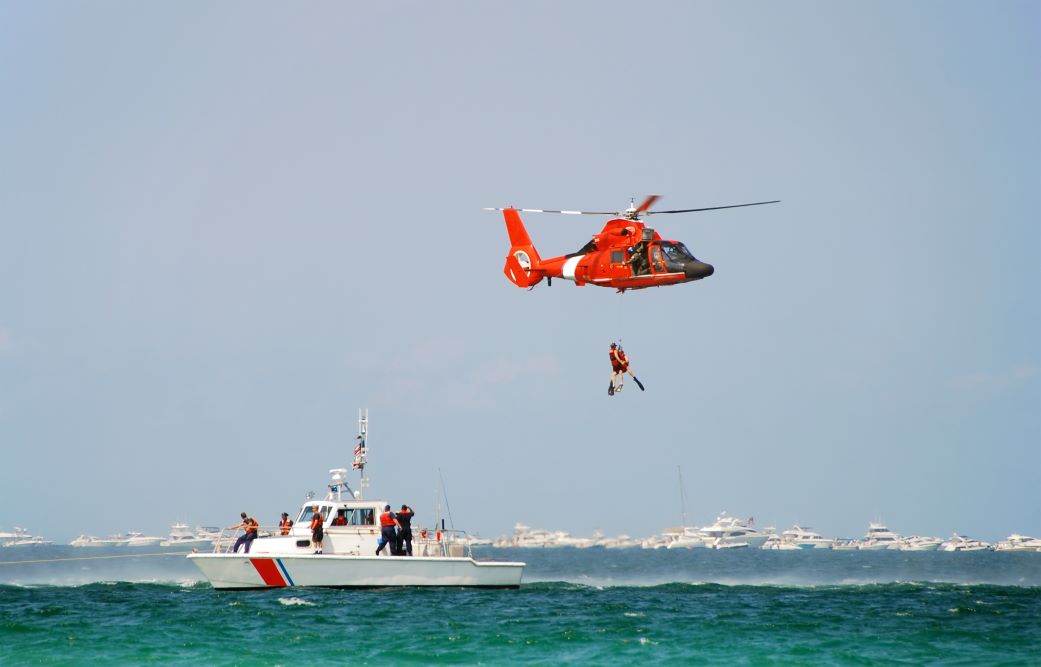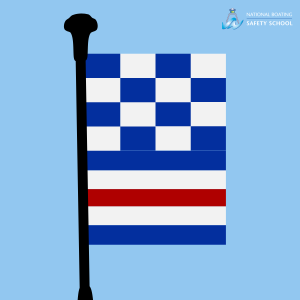
Types of Boating Distress Signals
If you are a pleasure boater operating a small craft, motorised vessel, sailboat or PWC, you need to be familiar with marine distress signals.
With boater safety in mind, we decided to create a complete guide to visual, audio and radio distress signals for all types of boaters.
Here are the most efficient ways to signal that your crew is in danger and recognize when another boat is in trouble and needs assistance.
Marine visual distress signals
Boaters can signal distress using flags, flares, smoke signals, markers and arm signals.
 Distress flags N over C
Distress flags N over C
To signal distress, you can use the methods established by the International Code of Signals (INTERCO), which is a global system of signals and codes designed for vessels to communicate essential messages about navigation safety and related issues. The International Signal for Distress is Code Flag ‘N’ (November) flown above Code Flag ‘C’ (Charlie).
 A ball over or under a square flag
A ball over or under a square flag
This marine visual distress signal consists of a square flag accompanied by a ball or ball-shaped object. The ball can be placed over or under the flag.
 S.O.S distress flag
S.O.S distress flag
The orange distress cloth or flag is designed to be visible to planes and helicopters during the daytime. It is a piece of orange cloth with a black square and a black circle on it.
 Rocket parachute flare (Type A)
Rocket parachute flare (Type A)
Another way to signal that you need assistance while boating is by sending up a rocket parachute flare. This type of flare creates a single red star that reaches a height of around 300 m (984 ft.), then floats down gently with the aid of a parachute. It can be seen easily from the ground or the air and burns for around 40 seconds.
 Multi-star flare (Type B)
Multi-star flare (Type B)
A multi-star flare can also be used to signal distress while boating. It creates two or more red stars, roughly 15 seconds apart, which reach a height of around 100 m (328 ft.). They are easily visible from the ground or the air from about 12 nautical miles and burn for 4 or 5 seconds.
Hand flare (Type C)
This distress signal consists of a red flame that burns at the end of a hand-held torch. The flame is difficult to spot from the ground, but is useful to pinpoint your position from the air. It burns for around a minute.
Floating or hand-held orange smoke signal (Type D)
This type of boating distress signal produces dense orange smoke for around 3 minutes and is most effective during the day.
Flames on the vessel
Flames can be used to alert other vessels that the crew is in distress. You can use a barrel of oil, tar or other combustible materials to create flames within a contained area, but be very careful to make sure they don’t get out of control. Always keep a boat fire extinguisher on hand.
Dye markers
During the day, you can release orange dye into the water to signal that you are in distress. This visual signal makes it much easier to spot your boat from the air, and is especially effective on windy days.
Arm signals
You can also signal distress by placing your arms straight out to the sides and moving them up and down slowly and repeatedly. (Don’t do this near a helicopter, because this signal means something different to them.)
Marine audio distress signals
 Gunshots or explosive sounds at one-minute intervals
Gunshots or explosive sounds at one-minute intervals
Firing off gunshots or making explosive sounds at one-minute intervals signals that you are in distress on a boat.
 Continuous sound from a foghorn, bell, whistle or other sound-signalling device
Continuous sound from a foghorn, bell, whistle or other sound-signalling device
Continuous sound from a sound-signalling device will alert other boats that you are in trouble and need help.
Marine radio distress signals
 SOS in Morse code (… —…)
SOS in Morse code (… —…)
If you have a device on board that allows you to communicate in Morse code, you can signal distress by transmitting an SOS.
 Repeat “MAYDAY” over VHF radio
Repeat “MAYDAY” over VHF radio
If you have a marine VHF radio on board and you need to send a distress signal (for example, if your boat is taking on water and you are in danger of sinking or capsizing due to a collision), use channel 16 and repeat “MAYDAY” 3 times. You must be ready to give the name of your boat, its position, the nature of your problem and the type of assistance you need.
 Dial *16 on your cell phone
Dial *16 on your cell phone
You can also use your cell phone to call for help and rescue by dialling *16. However, cell phones do not always work well on the water and should not be considered a substitute for VHF radio.
 Emergency Position Indicating Radio Beacon (EPIRB)
Emergency Position Indicating Radio Beacon (EPIRB)
If you have the equipment on board, an Emergency Position Indicating Radio Beacon (EPIRB) can be an effective way of signalling distress.
NBSS: your resource for boating safety information
Remember that the boating distress signal you should use will depend on the time of day (day or night), weather conditions and the boat safety equipment you have on board.
Want to learn more about boating safety and pleasure boating? The National Boating Safety School is your best resource. Our boating safety course is the ideal tool to help you prepare for the Transport Canada online boating exam, which is required in order to obtain your Pleasure Craft Operator Card and take to the water legally in Canada.

















